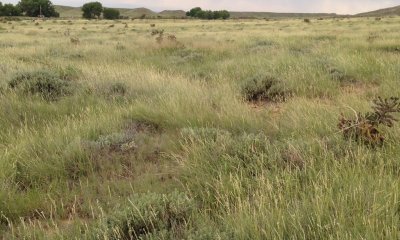
Shaly Plains
Scenario model
Current ecosystem state
Select a state
Management practices/drivers
Select a transition or restoration pathway
-
Transition T1A
Heavy, continuous grazing.
More details
Lack of fire. -
Transition T1B
Long-term, heavy, continuous grazing.
More details
Lack of fire. -
Transition T1C
Mechanical tillage.
More details -
Restoration pathway R2A
Prescribed grazing.
More details
Prescribed fire. -
Transition T2A
Long-term, heavy continuous grazing.
More details
Lack of fire. -
Restoration pathway R3A
Long-term prescribed grazing.
More details
Prescribed fire. -
No transition or restoration pathway between the selected states has been described
Target ecosystem state
Select a state
Description
The Reference state is characterized by three community phases that exist within the natural range of variability for the site. These phases are maintained by a historic fire frequency estimated to be on 15 to 20 year intervals, grazing by large ungulates, and adequate recovery periods. High production of perennial grasses and extensive soil cover allow for increased soil moisture retention, vegetative production, and overall soil quality.
Submodel
Description
The Shortgrass Dominated state contains one community phase which is dominated by blue grama. This is a very stable state, resistant to change due to the high tolerance of blue grama to grazing. The loss of dominant and subdominant functional/structural groups such as warm and cool-season grasses, nitrogen fixing legumes, and shrubs reduces the biodiversity and productivity of this site.
Submodel
Description
The Increased Bare Ground state lacks stability, diversity, and productivity. Litter levels are extremely low. Most of the palatable grasses, forbs, and shrubs have been replaced by less palatable species. Due to the increased bare ground erosion is evident where flow paths are continuous. Rills may occur on steeper slopes. The nutrient cycle, water cycle, and overall energy flow are greatly impaired. Organic matter and carbon reserves are greatly reduced.
Submodel
Description
This state is defined by two separate vegetation communities that are highly variable. They are derived through two distinct management scenarios, and are not successionally related. Infiltration, runoff, and soil erosion vary depending on the vegetation present.
The Reference state has been driven beyond the limits of ecological resilience and has crossed a threshold into the tillage state. The designation of the Tillage State denotes changes in plant community composition and soil structure. This change in plant species and soil structure affects the hydrologic function, biotic integrity, and soil site stability.
Submodel
Mechanism
Heavy, continuous grazing without adequate recovery opportunity between grazing events and lack of fire contribute to the loss of state resilience and result in shifts between states. This transition involves a major loss of plant diversity resulting in the degradation of biotic integrity.
Mechanism
Long-term, heavy, continuous grazing without adequate recovery opportunity and lack of fire will shift the plant communities within this state across an ecological threshold to the Increased Bare Ground State. This transition can occur within a 10-20 year time frame.
Mechanism
Tillage (plowed & abandoned) causes this state to transition across an ecological threshold to the Tilled State. The resulting change in plant species and soil structure adversely affect hydrologic function, biotic integrity, and soil site stability. This transition is considered to be non-restorable to the due to the adverse effects on the ecological functioning of the plant communities in the Tilled State.
Mechanism
Prescribed grazing management with proper stocking, adequate rest, and prescribed fire are the management actions required to recover to the Reference State. The species to target
for management are those that were dominant or sub-dominant within the reference plant community according to documented functional/structural groups. This restoration may take greater than 40 years to accomplish.
Relevant conservation practices
| Practice | External resources |
|---|---|
|
Prescribed Burning |
|
|
Prescribed Grazing |
Mechanism
Long-term, heavy continuous grazing without adequate recovery periods between grazing events and lack of fire moves the Blue Grama State across an ecological threshold to the Increased Bare Ground State. This transition may take greater than 25 years to accomplish. Resilience and resistance to disturbance will be lost. Soil site stability, hydrologic function, and biotic integrity will be significantly altered.
Mechanism
Long-term prescribed grazing with adequate recovery periods between grazing events and prescribed fire are the management actions required to recover to the Reference State. The species to target for management are those that were dominant or sub-dominant within the reference plant community according to the documented functional/structural groups. It is theorized that this restoration may take greater than 80 years to accomplish.
Relevant conservation practices
| Practice | External resources |
|---|---|
|
Prescribed Burning |
|
|
Prescribed Grazing |
Model keys
Briefcase
Add ecological sites and Major Land Resource Areas to your briefcase by clicking on the briefcase (![]() ) icon wherever it occurs. Drag and drop items to reorder. Cookies are used to store briefcase items between browsing sessions. Because of this, the number of items that can be added to your briefcase is limited, and briefcase items added on one device and browser cannot be accessed from another device or browser. Users who do not wish to place cookies on their devices should not use the briefcase tool. Briefcase cookies serve no other purpose than described here and are deleted whenever browsing history is cleared.
) icon wherever it occurs. Drag and drop items to reorder. Cookies are used to store briefcase items between browsing sessions. Because of this, the number of items that can be added to your briefcase is limited, and briefcase items added on one device and browser cannot be accessed from another device or browser. Users who do not wish to place cookies on their devices should not use the briefcase tool. Briefcase cookies serve no other purpose than described here and are deleted whenever browsing history is cleared.
Ecological sites
Major Land Resource Areas
The Ecosystem Dynamics Interpretive Tool is an information system framework developed by the USDA-ARS Jornada Experimental Range, USDA Natural Resources Conservation Service, and New Mexico State University.
